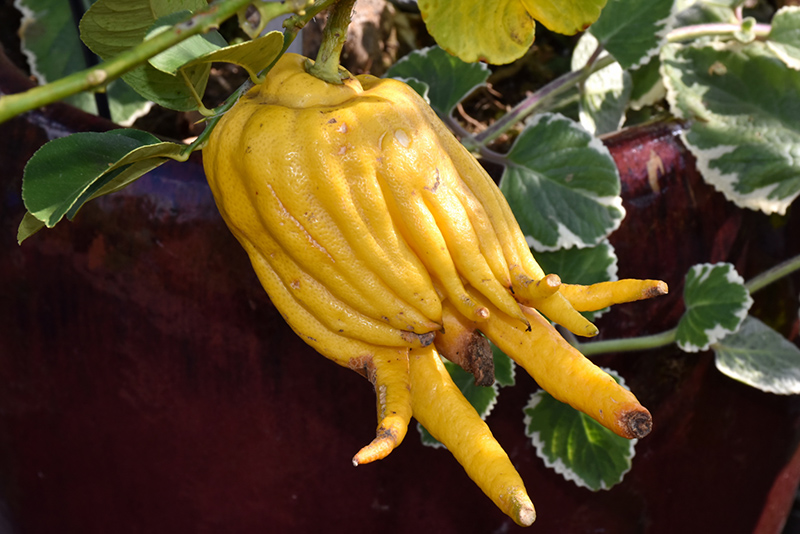Buddha's Hand Citron Citrus medica var. sarcodactylis Height: 15 feet Spread: 12 feet
Sunlight:
Hardiness Zone: 10a Description: This thorny shrub or small tree is one of the original citrus species; unique fruit that separates as it ripens into finger-like projections with an inner white pith that can be grated for zest; intolerant of drought, frost, or hot summer conditions Ornamental Features Buddha's Hand Citron features showy clusters of fragrant white star-shaped flowers with buttery yellow eyes at the ends of the branches from early spring to mid fall, which emerge from distinctive lilac purple flower buds. It has dark green evergreen foliage. The glossy oval leaves remain dark green throughout the winter. It produces yellow berries from late fall to late winter. The fruit can be messy if allowed to drop on the lawn or walkways, and may require occasional clean-up. This plant is primarily grown as an ornamental, but it's also valued for its edible qualities. The large pointy bitter fruit is most often used in the following ways: Landscape Attributes Buddha's Hand Citron is a multi-stemmed evergreen shrub with an upright spreading habit of growth. Its average texture blends into the landscape, but can be balanced by one or two finer or coarser trees or shrubs for an effective composition. This shrub will require occasional maintenance and upkeep, and is best pruned in late winter once the threat of extreme cold has passed. It is a good choice for attracting birds, bees and butterflies to your yard. Gardeners should be aware of the following characteristic(s) that may warrant special consideration; Buddha's Hand Citron is recommended for the following landscape applications; Planting & Growing Buddha's Hand Citron will grow to be about 15 feet tall at maturity, with a spread of 12 feet. It has a low canopy with a typical clearance of 1 foot from the ground, and is suitable for planting under power lines. It grows at a slow rate, and under ideal conditions can be expected to live for 50 years or more. This is a self-pollinating variety, so it doesn't require a second plant nearby to set fruit. This shrub should only be grown in full sunlight. It does best in average to evenly moist conditions, but will not tolerate standing water. It is not particular as to soil pH, but grows best in sandy soils. It is somewhat tolerant of urban pollution. This species is not originally from North America. Buddha's Hand Citron makes a fine choice for the outdoor landscape, but it is also well-suited for use in outdoor pots and containers. Its large size and upright habit of growth lend it for use as a solitary accent, or in a composition surrounded by smaller plants around the base and those that spill over the edges. It is even sizeable enough that it can be grown alone in a suitable container. Note that when grown in a container, it may not perform exactly as indicated on the tag - this is to be expected. Also note that when growing plants in outdoor containers and baskets, they may require more frequent waterings than they would in the yard or garden.![]()
![]()
![]()
![]()
![]()
![]()
![]()
![]()
![]()
![]()
![]()
top of page
Louie's Nursery Menifee - Plant Finder
Characteristics
Applications
Features & Attributes
This tool is an online resource representing many of the varieties that we carry over the course of the season, and is intended for informational purposes only. Inventory varies seasonally, so we cannot guarantee that every plant will be in stock at all times - please contact the store directly for current availability. It does not include our entire selection of plants, so be sure to visit our store to see varieties that may not be represented on this list.
bottom of page
